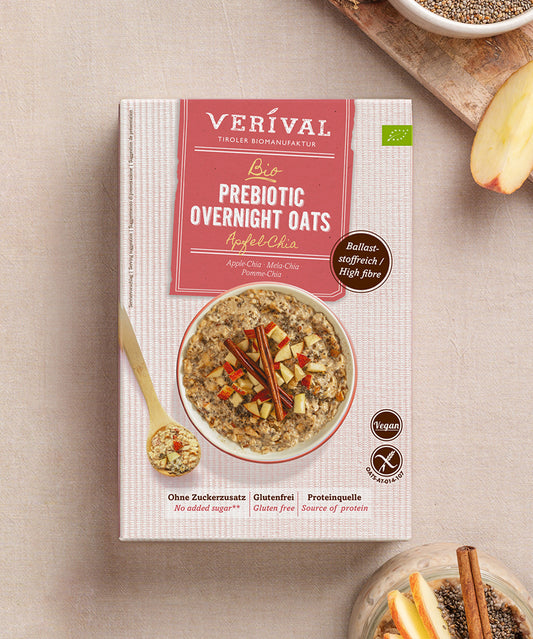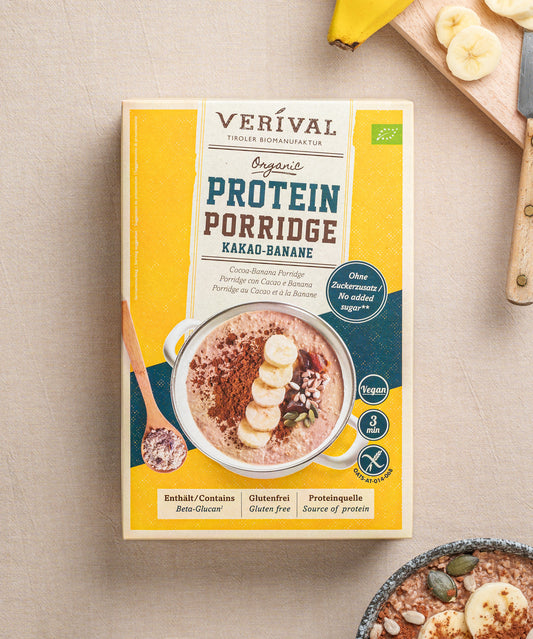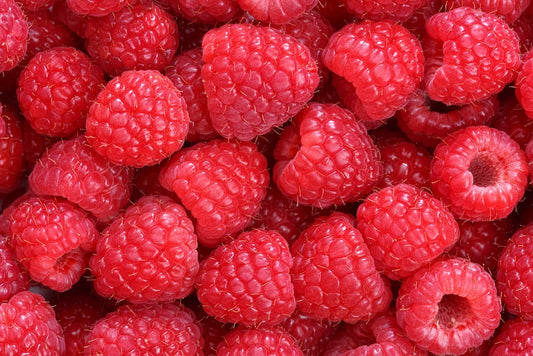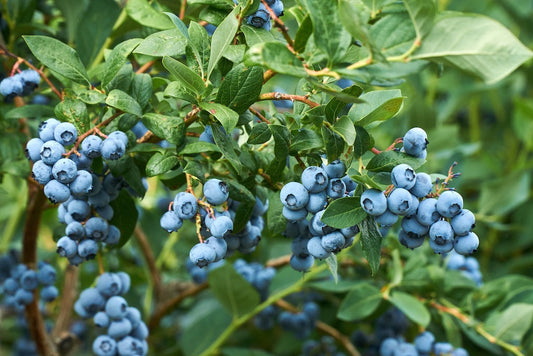Sugar. One food, many different opinions. Sugar is a topic that is discussed and debated like few others. We often read about the many harmful effects of sugar on the body. Sugar makes us fat, addictive and promotes various diseases such as type 2 diabetes.
These are just some of the headlines that immediately catch your eye when you take a closer look at the topic of sugar. But how harmful is sugar really for us? How much sugar does our body need? Does sugar really make us ill? We have taken a closer look at these and other questions relating to sugar and would now like to share our findings with you.
Low-sugar breakfast from Verival
What is sugar?
From a purely chemical point of view, sugar is called sucrose. To be precise, table sugar consists of disaccharides (double sugars), which are made up of the monosaccharides (simple sugars) glucose (grape sugar) and fructose (fruit sugar).
Table sugar is mainly obtained from the two green plants sugar cane and sugar beet during photosynthesis, as these are the only plants that can store sugar in large quantities.
How many calories does sugar have?
Sugar consists of 100% carbohydrates and is therefore a source of carbohydrates in its purest form. 100 grams of sugar therefore contain 100 grams of carbohydrates. With 387 calories per 100 grams, sugar is a food with a high calorie density. The physiological energy value of sugar is therefore 4 kcal (16.8 kJ) per gram.
Does our body need sugar?
Even though sugar is often referred to as the white poison of the 21st century, our body needs carbohydrates. This is because carbohydrates are our body's preferred source of energy. The simple sugar glucose is our most important source of energy, as our brain alone burns around 130-140 grams of glucose per day.
However, our bodies can also produce sugar themselves by breaking down polysaccharides (starch), which are found in bread and pasta, for example. To answer the question of whether our bodies really need sugar, the answer is yes: our bodies need sugar because it is an important source of energy for the human organism.
How is sugar processed by the body?
Since there are different types of sugar, namely simple sugars, double sugars and multiple sugars, they are broken down differently by our body.
Glucose (glucose) or table sugar (sucrose), which consists of half glucose and half fructose, can be quickly utilised and absorbed by the body. These simple sugars enter our bloodstream quickly in their direct form via the intestines and cause our blood sugar levels to rise rapidly. This quickly supplies our body and brain with the energy it needs.
In a similar way, but somewhat slower, fructose and glucose in fruit and vegetables are processed by our body and the sugar they contain also enters our bloodstream quickly.
Blood sugar levels rise most slowly when we consume complex sugars, such as starch, which is found in cereals, potatoes, bread and legumes. This is because the body first has to convert the starch into glucose. Only after this conversion can the glucose be transported via the blood to the individual cells.
Does sugar make you ill?
When we consume sugar or sugary foods, our blood sugar levels rise. These fluctuations in blood sugar can be balanced out by the body. However, this is only the case if these fluctuations occur within normal limits. Excessive consumption of industrial sugar can put strain on our bodies, as the pancreas has to release large amounts of insulin quickly to normalise blood sugar levels.
Over time, the pancreas can become overwhelmed and unable to produce enough insulin. This means that blood sugar levels no longer drop to normal levels and our cells can become insulin resistant.
In the worst case, this condition can lead to type 2 diabetes. Therefore, as in many other cases, the amount is crucial. Because when it comes to sugar, it's the amount that makes it toxic. So sugar does not automatically make us ill; ultimately, it is the amount that matters.
What are the symptoms of high sugar consumption?
Excessive sugar consumption can have various symptoms. These include the following:
- Constant hunger
- Fatigue
- Extreme thirst
- Unintentional weight loss
- Difficulty concentrating
- Frequent infections
- Vision problems or blurred vision
- Frequent urination
If you experience any symptoms of high sugar consumption, you should consult a doctor and take a closer look at your sugar intake.
Is white or brown sugar healthier?
Although at first glance brown sugar may look like the wholemeal version of white sugar, this is not the case. Brown sugar simply contains slightly more minerals and vitamins than its white counterpart. Brown sugar is whole sugar from beet and whole cane sugar from sugar cane.
The brownish colour of brown sugar comes from the molasses, a substance produced during sugar processing, which is not removed. As brown sugar is therefore hardly any different from white sugar, neither is healthier than the other.
What natural alternatives to sugar are there?
Here is an overview of various sugar alternatives:
- Honey
- Agave syrup
- Dates
- Rice syrup
- Maple syrup
- Ripe bananas
- Coconut blossom sugar
- Apple syrup
- Stevia
Is honey better than sugar?
Honey is a natural sugar alternative. Honey consists of 80% sugar, namely glucose and fructose, and 20% water. As honey is slightly sweeter than conventional table sugar due to its higher fructose content, you need less honey than sugar to achieve the same sweetness.
Although honey contains very similar substances to sugar, from a nutritional point of view it has a different effect on our bodies than table sugar. Even though honey is a natural product, it can damage our teeth, intestines and pancreas just like table sugar if consumed in excess. It should therefore be used sparingly.
Agave syrup compared to sugar
Agave syrup is extracted from the agave plant, tapped and then boiled down to a syrup. As agave syrup is composed of a mixture of fructose and glucose, it has one of the lowest glycaemic indices of all natural sweeteners.
(For information: the glycaemic index (GI) indicates the effect of a carbohydrate-containing food on blood sugar levels). The GI of agave syrup is around 20%, compared to 70% for table sugar.
This means that blood sugar levels rise and fall much more slowly when agave syrup is consumed, which can help prevent cravings. Agave syrup also has around 100 fewer calories per 100g than regular white sugar. However, the nutritional value of agave syrup is similar to that of sugar.
This makes it a slightly healthier alternative to conventional table sugar, but it should still be enjoyed in moderation.
Dates and date syrup compared to sugar
Although the fructose content in dates is the same as in table sugar, dates contain various minerals such as folic acid, iron, magnesium, potassium and vitamins A and D.
Dates are also suitable for diabetics and, with an energy density of only 282 calories per 100 g (compared to 387/100 g in sugar), they are slightly lower in calories than sugar. Blood sugar levels do not rise as quickly when dates are consumed, but they still provide us with energy quickly.
Our new TCM porridges, for example, are sweetened with dates.
Maple syrup compared to sugar
Like honey, maple syrup is a natural alternative to sugar. Maple syrup is the thickened sap of the sugar maple tree. Compared to conventional table sugar, maple syrup contains various minerals such as potassium, iron and magnesium.
Incidentally, the quality of maple syrup can be determined by its colour: the lighter the syrup, the higher the quality. Maple syrup has a sugar content of around 65 percent. It is also rich in various minerals and has a lower calorie content than honey or sugar.
This makes maple syrup a slightly healthier alternative. Compared to table sugar, you can save 35 percent in calories.
How much sugar is healthy per day? Your daily sugar requirement
An adult should consume a maximum of 50 g of sugar with a calorie intake of around 2000 calories. According to the latest publications from the World Health Organisation (WHO), you should consume no more than 5 per cent of your total calorie intake in sugar, which is around 25 g of sugar per day.
These percentages refer to the intake of so-called free sugar. Free sugar includes monosaccharides (glucose and fructose) and disaccharides (such as sucrose or table sugar).
Free sugar can be added to food and drinks in the form of added sugar or is naturally present in honey, syrup, fruit juice concentrates and fruit juices. The WHO does not recommend a maximum intake for sugar contained in fruit, vegetables and various dairy products.
Breakfast without added sugar from Verival – discover it here
Low-sugar breakfast from Verival
The topic of sugar is also becoming increasingly important for us at Verival. That's why many of our mueslis and porridges are already free from added sugar. Our new TCM porridges, for example, are only naturally sweetened with dates.
If you are particularly conscious of a low-sugar diet, you can easily filter our products without added sugar in our Verival online shop. Simply select ‘No added sugar’ in the filter and you can easily discover your breakfast without added sugar.
Even though sugar is often demonised as the white poison of the 21st century, consuming sugar in small amounts is not harmful. The human body needs sugar as a source of energy to function properly.
According to the WHO, to prevent various diseases, you should keep the amount of free sugar as low as possible and avoid added sugar, especially table sugar. But as with any other food, it's the amount that makes it harmful, so it's perfectly fine to consume sugar in small quantities.
























